By Duncan Graham
The Brits would have
loved it. Deep in the heart of East Java the Union Jack was carried with
pride, waved with vigor and cheered by thousands.
But the only
blondes bobbing in the swirling ocean of soccer fanatics were two benign
Belgians, disguising any assumption that they might be Dutch or
American. Their trick was to pull on Harry Potter cloaks of
invisibility, in this case T-shirts screaming love for Arema soccer
club.
Paul Beetens and Annie Aertsen need not have bothered. Had
the boisterous crowd known the couple was from the tiny royalty that has
become the darling of European soccer, they would have been mobbed as
heroes at Arema’s ginormous birthday bash in Malang.
The day-long
show celebrated 29 years of less than spectacular successes on the
field — Arema was last trounced by Persipura Jayapura — but almost three
decades of heartfelt hope and soul-wrenching prayer. With wet cheeks it
recalls 2010, the year of majesty when it reigned over the Indonesian
Super League.
To revive the fatigued ambition the fans painted
the town blue. Although Aug. 11 is the official 1987 birthday, the
police persuaded organizers to shift to the nearest Sunday to minimize
disruption. The tactic was a success. Total chaos was reduced by 5
percent — gridlock by marginally less.
The Belgian tourists
thought the event a hoot. And a roar, amplified by 100,000 Hondas, plus a
backing choir of Suzukis and Yamahas.
“It’s a celebration of
solidarity,” they shouted. “Everyone seems happy. We’re lucky to be here
at this time. We came for a trip to Bromo — and this is a bonus.”
Malang’s
followers did not get labeled Aremaniacs by holding soirees with the
gentry so security was intimidatory. “Was” because threat fatigue soon
set in — as it does wherever trouble is imagined. Suspicion is a
high-maintenance emotion with a short shelf life.
A squad from
the police’s Mobile Brigade (Brimob) in age-of-terror black vaulted from
a Barracuda Armed Personnel Carrier (APC) that looked like a giant
toad. They checked packs of tear-gas cartridges, slung Pindad SS1
assault rifles across their chests and swaggered into the front line.
The
everyday cops, eclipsed by this awesome show of military might, showed
their authority by pulling out traffic offenders and disarming riders
carrying flagpoles.
“To stop them being used as weapons,” said a
policewoman, who then used a confiscated stick to whack the bottom of a
fan giving cheek.
Arema’s birthday party is one great
do-it-yourself shebang, at odds with the official choreographed Aug. 17
Proclamation Day events where goose-stepping discipline rules. The
handmade banners often use English to add status, though the grammar and
spelling tended to dampen that desire.
Though the mob was
largely male the event was egalitarian. Women may have been outnumbered,
but they compensated with enthusiasm by pillion dancing and urging the
drummers to bang harder.
Teenage Fitri’s message across her
bosom was encouraging: “Football For Unity, Indonesia is not Iran or
Saudi Arabia, so a woman’s place is almost everywhere”.
The Union
flags were there to inspire. The UK teams are models for Arema fans who
wish their lads could be as skilled and focused as Manchester United.
In Malang it is the English leagues that excite. The fans trickled
through the gauntlet of gendarmes, and then opened throttles for
circuits around the flower beds before the town hall. The courtyard was
fronted by two blue fiberglass lions, so kitsch they would not make it
into a Disney cartoon movie.
Suddenly the police radios
sputtered and the uniforms dashed away. Clearly a fight had erupted, or —
shock, horror or maybe a suspicious package. Fortunately it was the
lunch bell and the packages contained the local alleged delicacy nasi
rawon (black beef soup).
This delighted the giggles seeking
selfies with men in black. The bullet-proof Barracuda began to melt. So
the doors were opened, letting the local guys goggle the weapons
wonderland. The greatest danger was not from a deranged knifeman but an
invisible toxin. The fans should have prayed for real winds of change.
Concentrated carbon monoxide kills. In lesser doses it sickens.
The
saddle dancers lost their balance, the banner boys began to flag, the
kids in lion masks stopped growling and started coughing. Arema’s
birthday is a fun show that should be on the tourist calendar, a
marvelous expression of organic togetherness.
But on a windless day in Malang it is a health hazard.
Duncan Graham is a journalist who resides in Malang, East Java, Indonesia.

Arema for life: Fans of Malang’s Arema soccer club, also known as
Aremania, stage a convoy during the club’s anniversary celebrations in
its hometown in East Java.(JP/Erlinawati Graham)(JP/Erlinawati Graham)

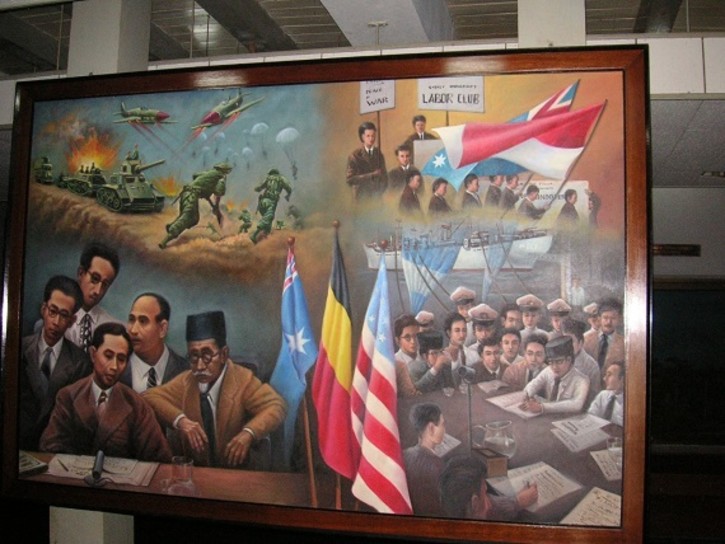
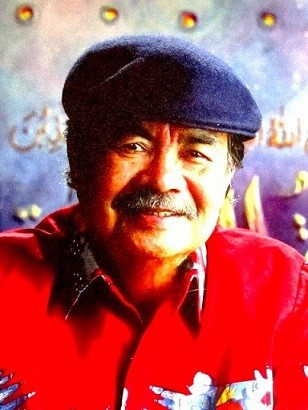 Amri Yahya Source: http://miesehati.com/wp-content/uploads/2010/12/amri-yahya.jpg
Amri Yahya Source: http://miesehati.com/wp-content/uploads/2010/12/amri-yahya.jpg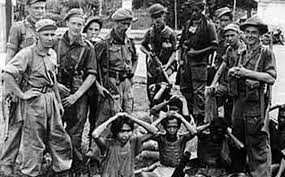 Dutch troops with captured Indonesian fighters Source: http://www.verzetsmuseum.org
Dutch troops with captured Indonesian fighters Source: http://www.verzetsmuseum.org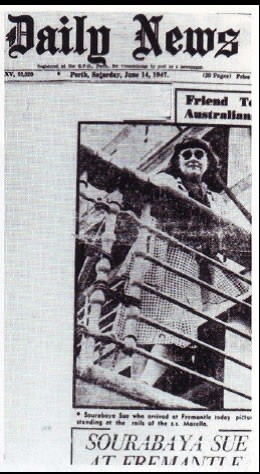 ‘Sourabaya Sue at Freemantle’, Daily News, 14 June 1947
‘Sourabaya Sue at Freemantle’, Daily News, 14 June 1947 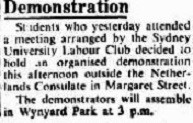 Sydney Morning Herald, 25 July 1947
Sydney Morning Herald, 25 July 1947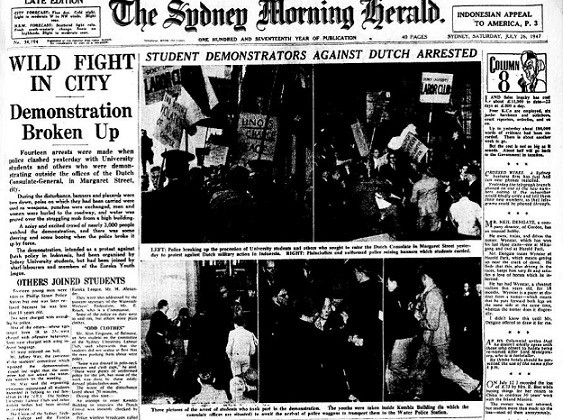 Front page, Sydney Morning Herald, 26 July 1947
Front page, Sydney Morning Herald, 26 July 1947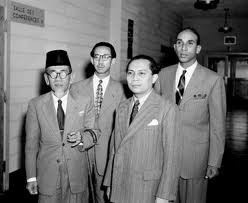 The
Indonesian delegation arriving before the Lake Success UN Security
Council meeting: (left to right): Agus Salim, Foreign Minister; Dr.
Soemitro, Minister of Finance; former Premier Sutan Sjahrir,
Ambassador-at-large; and C. Thamboe, Minister of Foreign Affairs. Source: UN Photo archive.
The
Indonesian delegation arriving before the Lake Success UN Security
Council meeting: (left to right): Agus Salim, Foreign Minister; Dr.
Soemitro, Minister of Finance; former Premier Sutan Sjahrir,
Ambassador-at-large; and C. Thamboe, Minister of Foreign Affairs. Source: UN Photo archive.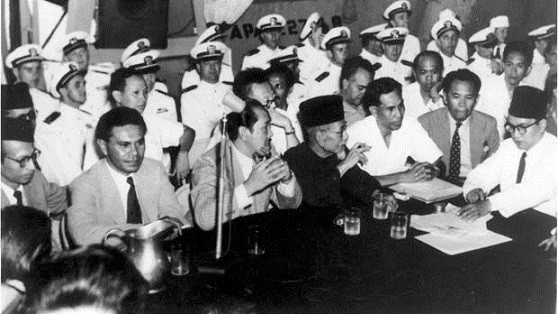 Photo
taken on 17 January 1948 on the deck of USS Renville shows (right to
left): Prime Minister Amir Syarifuddin, Setiadjit, Johannes Leimena, H.
Agus Salim, Ali Sastroamidjojo, and Latuharhary. Source: leimena.org
Photo
taken on 17 January 1948 on the deck of USS Renville shows (right to
left): Prime Minister Amir Syarifuddin, Setiadjit, Johannes Leimena, H.
Agus Salim, Ali Sastroamidjojo, and Latuharhary. Source: leimena.org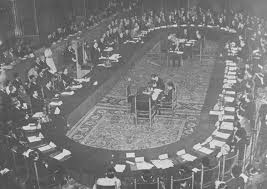 The Round Table Conference in session Source: wikipedia
The Round Table Conference in session Source: wikipedia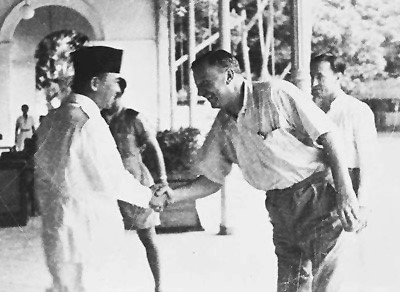 Jogjakarta, 16 November 1947, Good Offices Committee (GOC) Chairman Judge Kirby brings Dutch proposal Source: http://www.sukarnoyears.com/440australia.htm
Jogjakarta, 16 November 1947, Good Offices Committee (GOC) Chairman Judge Kirby brings Dutch proposal Source: http://www.sukarnoyears.com/440australia.htm